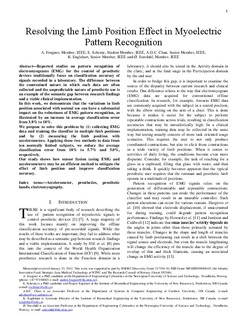Resolving the Limb Position Effect in Myoelectric Pattern Recognition
Journal article, Peer reviewed
Permanent lenke
http://hdl.handle.net/11250/2392260Utgivelsesdato
2011Metadata
Vis full innførselSamlinger
Originalversjon
IEEE transactions on neural systems and rehabilitation engineering 2011, 19(6):644-651 10.1109/TNSRE.2011.2163529Sammendrag
Reported studies on pattern recognition of electromyograms (EMG) for the control of prosthetic devices traditionally focus on classification accuracy of signals recorded in a laboratory. The difference between the constrained nature in which such data are often collected and the unpredictable nature of prosthetic use is an example of the semantic gap between research findings and a viable clinical implementation.
In this work, we demonstrate that the variations in limb position associated with normal use can have a substantial impact on the robustness of EMG pattern recognition, as illustrated by an increase in average classification error from 3.8% to 18%.
We propose to solve this problem by (1) collecting EMG data and training the classifier in multiple limb positions and by (2) measuring the limb position with accelerometers. Applying these two methods to data from ten normally limbed subjects, we reduce the average classification error from 18% to 5.7% and 5.0%, respectively.
Our study shows how sensor fusion (using EMG and accelerometers) may be an efficient method to mitigate the effect of limb position and improve classification accuracy.
